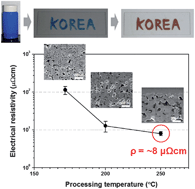Highly conductive polymer-decorated Cuelectrode films printed on glass substrates with novel precursor-based inks and pastes
Abstract
Novel inks and pastes based on a

* Corresponding authors
a
Electronics Material Laboratory, Advanced Material Research Center, Samsung Advanced Institute of Technology (SAIT), Yongin, Gyeonggi, Republic of Korea
E-mail:
yh80.choi@gmail.com
Fax: +82-31-280-9207
Tel: +82-31-280-6720
Novel inks and pastes based on a

 Please wait while we load your content...
Something went wrong. Try again?
Please wait while we load your content...
Something went wrong. Try again?
Y. Choi, J. Lee, S. J. Kim, D. Yeon and Y. Byun, J. Mater. Chem., 2012, 22, 3624 DOI: 10.1039/C2JM15124C
To request permission to reproduce material from this article, please go to the Copyright Clearance Center request page.
If you are an author contributing to an RSC publication, you do not need to request permission provided correct acknowledgement is given.
If you are the author of this article, you do not need to request permission to reproduce figures and diagrams provided correct acknowledgement is given. If you want to reproduce the whole article in a third-party publication (excluding your thesis/dissertation for which permission is not required) please go to the Copyright Clearance Center request page.
Read more about how to correctly acknowledge RSC content.
 Fetching data from CrossRef.
Fetching data from CrossRef.
This may take some time to load.
Loading related content
